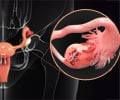A study in the December 11th issue of the journal Cell, a Cell Press publication says that the ovaries of mice can be reprogrammed into testes by silencing a single gene.
A study in the December 11th issue of the journal Cell, a Cell Press publication says that the ovaries of mice can be reprogrammed into testes by silencing a single gene.
The findings may have implications for understanding certain sex disorders in children and premature menopause in women, the researchers say.No one would have previously suspected or believed that an adult organ could be "transdifferentiated" to such an extent by changing a single gene, said Mathias Treier of the European Molecular Biology Laboratory and the University of Cologne in Germany. "No one would have betted on this," he said. "That's why the finding is so spectacular."
Until a few years ago, conventional wisdom held that terminally differentiated organs in adult mammals couldn't be reprogrammed. The new findings add to a growing list of exceptions to that rule.
They also revise scientists' understanding of sex determination, which held that ovaries are the default identity for the gonads. In almost all mammals, males are XY and females XX. A transcription factor known as SRY, which is found on the Y chromosome, is normally responsible for triggering the indifferent gonads to develop as testes rather than ovaries. SRY induces the activity of another gene, known as Sox9, which takes over from there.
Now the researchers show that the transcription factor, FOXL2, is required to keep Sox9 turned off in the adult ovary. Without it, Sox9 comes on and the identity of ovarian cells "flip-flops," turning them into testicular cells.
Treier's team has been studying the role of the Foxl2 gene for some time and a few years ago published the results of a study in which they deleted the gene from mice altogether. It turned out female mice lacking FOXL2 during development don't experience a sex reversal as Treier had thought they might. Rather, their ovaries fail to develop properly and degenerate.
Advertisement
"This shows that the maintenance of the ovarian phenotype is an active process throughout life," Treier said. "Like Yin and Yang, FOXL2 and SOX9 oppose each other's action to ensure together the establishment and maintenance of the different female and male supporting cell types respectively."
Advertisement
"When estrogen declines [in menopause], part of the ovary may switch to a testicle-like structure," he said. One way to prevent that from happening is estrogen replacement therapy, but of course that kind of hormonal therapy has been shown to come with other health risks. Treatments designed to modulate FOXL2 activity may be another way to interfere with this process, he said.
The findings likely are relevant to sex reversals seen elsewhere in the animal kingdom, notes Andrew Sinclair and Craig Smith of Murdoch Children's Research Institute in an accompanying commentary.
"The loss of Foxl2 is likely to be the sole underlying cause of female-to-male sex reversal observed in goats with polled intersex syndrome, which have a large chromosomal deletion of the region including the Foxl2 gene," they wrote. "Furthermore, the phenomenon of adult stage sex conversion seen in many fish may be explained by interaction between FOXL2/estrogen receptor and SOX9."
Source-Eurekalert
RAS










